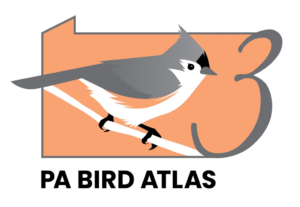PBA3 State Birding Initiative
Birders across Pennsylvania are joining to gather the needed information for the Third Pennsylvania Bird Atlas. Using birders across the state, the atlas hopes to achieve uniform coverage with data regarding the outlook of birds in Pennsylvania.
The Third Pennsylvania Bird Atlas (PBA3) is a five-year-long survey running from January 2024 to February 2029. It is a comprehensive study to document the breeding bird species of Pennsylvania. The information gathered will help update range maps with expansions and reductions, populations changes, and more.
The Pennsylvania Game Commission is partnering with Hawk Mountain Sanctuary, with additional support from the Pennsylvania Society for Ornithology and the Pennsylvania Bird Atlas Steering Committee for the PBA3.
The Pennsylvania Game Commission has managed the Commonwealth’s resources through management, monitoring, restoration, and other research for over 100 years. Through their partnership with these other organizations, vital research into the birds of Pennsylvania and their distribution will help with potential conservation efforts to ensure the future of Pennsylvania birds.
When it was created in 1934, Hawk Mountain Sanctuary was the world’s first refuge for birds of prey. Hawk Mountain is dedicated to the study and preservation of raptor species, and its sanctuary connects people with the beauty of raptors.
The PBA3 is divided into two parts, each lasting five consecutive seasons. The Breeding Atlas begins in January 2024, and the new-this-year Winter Atlas begins the winter of 2024-25. The full conclusion of the PBA3 will be in early 2029.
The PBA3 is also divided into regions across Pennsylvania: Northwest, Southwest (including Greene, Fayette, and Washington counties), Allegheny Plateau, Ridge and Valley, Upper Susquehanna, Lower Susquehanna, Northeast, and Southeast. The regions are then divided into blocks.

Collecting & Sharing Your Data
To ensure that the atlas can use your information, the PBA3 has established a checklist and guidelines. You must submit your checklists through the Pennsylvania Bird Atlas (mobile) or online at eBird’s Atlas portal.
It’s important to provide a count or estimate of the individuals observed, stay within a one mile traveling distance, keep the time to 30 minutes or less, stay within a single block, pay attention to bird behaviors, and use the breeding codes. Nocturnal checklists must start at least 20 minutes after sunset and 40 minutes before sunrise.
Unlike previous atlases, the PBA3 will use eBird for data collection. eBird is one of the largest, collaborative citizen science projects, with information from birders across the world managed by the Cornell Lab of Ornithology.
As a birder, you can manage lists, share photos and audio recordings, see real-time maps, and get alerts on bird species. You can visit the Pennsylvania Bird Atlas’s home on eBird at https://ebird.org/atlaspa/home.
A PBA3 Volunteer Handbook is available for download on eBird that will help you with information about survey methods, when/where to survey, strategies for effecting atlasing, breeding code information, data collection and entry, and more.








